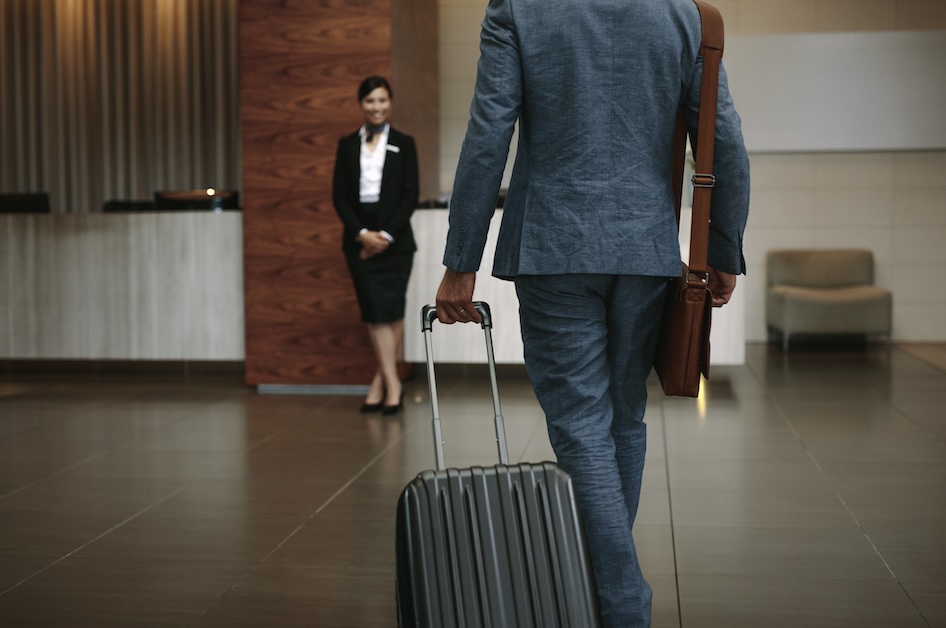
Prioritizing sustainable business travel
GBTA’s recent report reveals that for companies, “the biggest drivers when it comes to sustainability uptake are reputation management (84%) coupled with a genuine willingness to drive a positive impact on the planet (82%).”
But while the majority of companies have sustainability goals in place—82%, according to a recent BCD Travel sustainability report—only 45% have goals specifically for sustainable business travel.
Why the discrepancy?
From communicating sustainable travel options at the company level to creating a standardized way for measuring the impact of business travel on the environment, there’s a lot of room for improvement. Thankfully, the business travel industry is moving in the right direction.
Reducing corporate carbon footprint through smart travel choices
At the end of the day, reducing a company’s carbon footprint comes down to making smart travel choices. Even small changes like going paperless with travel documents, bringing a refillable water bottle, supporting local restaurants, and avoiding single-use plastic make a big difference in the long run. But for more immediate and significant sustainability improvements, business travelers need to rethink their flights, accommodations, and local transportation.
Flying smarter
Choosing Direct Flights to Lower Emissions
One simple step is to choose direct flights whenever possible. Not only does this reduce the overall distance traveled, but it also eliminates the need for layovers and additional takeoffs and landings, which is when most emissions occur. In fact, a study by the International Civil Aviation Organization found that direct flights can reduce carbon emissions by up to 50% compared to connecting flights.
Opting for Economy Class Over Business Class
Another way to reduce your carbon footprint is by flying economy instead of business class. While it may be tempting to indulge in the extra legroom and amenities, the truth is that business class seats take up more space and weight on the plane—which means more fuel burned and more emissions produced. In fact, a World Bank study found that flying business class can have a carbon footprint up to three times larger than flying economy.
Why?
The carbon footprint per passenger is lower in economy due to higher seating density. In simpler terms, because more people are packed into a smaller space, each person’s share of the total emissions produced by the aircraft is reduced.This efficiency arises from maximizing the use of available space on an airplane, whereas business and first-class seats take up more room for fewer passengers, leading to a larger carbon footprint per individual.
Additionally, flying economy can indirectly contribute to reducing overall demand for spacious seating options like those offered in business or first class. When airlines notice decreased interest in these premium categories, they may opt for configurations that prioritize more eco-friendly layouts—effectively lowering per-flight emissions by accommodating more passengers with less environmental impact.
Another point to consider is resource consumption onboard. For example, luxury classes often include enhanced dining experiences and amenities, which not only require additional physical resources but also generate extra waste compared to the streamlined services provided in economy. From elaborate meal services using non-reusable materials to increased laundry loads for linens used exclusively in these sections, the cumulative effect increases each flight’s environmental toll.
Minimizing Luggage Weight
Less baggage means lighter aircraft. Consequently, by limiting personal belongings to what can fit in an overhead bin or under a seat, travelers effectively reduce the total weight being carried on their journey. This reduction leads directly to lower fuel consumption per flight—a critical consideration given aviation fuel’s high carbon intensity and its direct correlation with greenhouse gas emissions.
Furthermore, this practice influences operational efficiencies beyond just the immediate fuel savings. Aircraft are designed and operated under strict weight limitations for safety and efficiency reasons—every extra pound requires careful management across loading procedures and may even impact routing decisions due to varying fuel needs. By minimizing checked luggage, airlines can streamline these processes significantly: quicker turnaround times at gates(since there’s less cargo to handle), potential reductions in required onboard staffing levels for handling passenger items during boarding and disembarkation phases, as well as diminished need for ground support equipment dedicated solely to baggage transport—all leading indirectly but substantially toward resource conservation.
But how do business travelers feel about limiting their luggage? BCD’s recent survey reveals that 4 in 10 travel with only carry-on luggage or make an effort to minimize the weight of their suitcase on business trips.
Choosing eco-friendly hotels
Business travel often involves staying in hotels—which means there are plenty of opportunities to reduce waste and support sustainable practices. In fact, according to GBTA’s report, 60% of hotels are planning and implementing carbon reduction measures, and more than 40% are currently measuring their carbon emissions. Some popular steps for hotels to be more sustainable include as using eco-friendly cleaning products, installing low-flow shower heads and toilets, and sourcing food from local farmers.
In addition to booking eco-friendly hotels, business travelers can take some simple actions to reduce their impact on the planet, such as include declining daily housekeeping services to save water and energy, using refillable toiletry bottles instead of single-use plastics, and properly sorting waste into recycling and compost bins. In fact, BCD Travel reports that business travelers are on board with such efforts, with 7 in 10 avoiding frequent towel changes and 6 in 10 skipping daily housekeeping.
Utilizing fuel-efficient ground transportation options
While air travel gets a lot of attention when it comes to sustainability, ground transportation is also a significant source of emissions. In fact, transportation is the largest contributor to greenhouse gas emissions in the United States, according to the Environmental Protection Agency. But there are plenty of ways to make ground travel more sustainable.
Car Rentals
One option is to rent fuel-efficient vehicles such as hybrids or electric cars. However, according to BCD Travel’s recent survey, a whopping 81% of business travelers don’t rent electric vehicles (EVs) due to poor logistics, range, and availability.
The publication The Company Dime has reported similar issues.
“It can be intimating to rent an EV,” Danielle Amoroso, Otsuka Pharmaceutical Companies U.S. travel expense associate director, told The Company Dime in their article, “Electric Vehicles and Business Travel:Navigating the Charging Landscape.” “If they have never driven an EV before, it’s out of their comfort zone. They may be in an area they are not familiar with, and they have to figure out how to operate a new car. There are so many logistics to consider that they never had to before. That’s a big part of the traveler hesitation.”
In fact, in Christopherson’s recent LinkedIn poll, business travelers echoed these sentiments, with the majority of the 45 respondents saying it was too much of a hassle to rent an electric vehicle.

The cost of renting an EV compared to a gasoline-powered vehicle can also be somewhat shocking.
“Rates are becoming more affordable but can be as high as double,” Dave Kilduff, chief revenue officer for NYC Limo VIP, told The Company Dime.
Public Transportation
Opting for trains rather than planes whenever possible can significantly reduce emissions on a per-person basis. However, they tend not to be a popular sustainable travel option with North American businesses, with just 5% offering trains as an alternative to flying, according to BCD Travel’s sustainability report.
Luxury bus lines such as Napaway, The Jet, RedCoach, and Vonlane are also gaining traction in certain areas of the country. Depending on the bus line, amenities can range from Wi-Fi, food and drink service, and noise-cancelling headphones to private suites.
“Slow travel”
Another business travel sustainability trend is a shift toward “slow travel”—taking longer trips with fewer flights and more time spent at each destination. According to GBTA, “74% of travel managers are encouraging (55%) or mandating (19%) their employees to combine multiple business trips into one.”
And BCD Travel reports that 55% of travelers absolutely agree (18%) or somewhat agree (37%) that they would willingly take fewer but longer business trips.
Effective communication strategies for promoting sustainable travel
One interesting stumbling block to widespread sustainable business travel is a lack of effective communication between travel buyers, travel managers, and travelers.
“Almost half of travel buyers mention traveler education as a challenge on the way to a sustainable travel program, yet 3 in 10 never communicate with their travelers on sustainability matters,” BCD Travel’s report states.
In fact, the same report also finds that only 20% of travelers are aware of their company’s travel sustainability goals.
Similarly, only 28% of travel managers are using their booking technology to encourage travelers to make more sustainable choices, according to GBTA’s report.
But what does effective communication look like?
Team discussions, regularly dedicated emails, competitions and incentives, and formal workshops are just a few suggestions. The important thing is to keep employees engaged and informed. Companies should also consider including sustainability measures in their travel policies.
SAP Concur offers a free sustainability policy template for travel programs, which includes some tips for engaging employees.
“Employees need to know what your travel sustainability commitments are, as well as how those commitments fit into the overall business plan and their individual work,” the template states. “Every part of your strategy should be meaningful and easy for employees to understand.”
Carbon offsetting in business travel
Even with the most sustainable travel practices, some carbon emissions are inevitable. That’s where carbon offsetting comes in—a way for companies to balance out their environmental impact by investing in projects that reduce greenhouse gases elsewhere.
But not all carbon offset programs are created equal. To ensure that your investment is actually making a difference, it’s important to choose a reputable provider with a track record of success. Look for programs that are transparent about their projects and have third-party verification of their impact. Some well-respected options include Voluntary Carbon Markets Integrity Initiative and the United Nations Carbon Offset Platform.
But as BCD Travel's VP of Sustainability, Olivia Ruggles Brice, warns, "Companies wishing to mitigate the impact of their travel emissions in this way still need to be careful about where they invest their money. It should be about contribution rather than offsetting."
Measuring and tracking environmental impact
Measuring the environmental impact of a company’s travel program can be confusing and complicated—especially because the business travel industry lacks standardized methods and tools.
“Lack of measurement and accounting standards for emissions (51%), lack of data and access to transparent information (47%), and booking tools not displaying sustainability features (41%) were all named as major barriers to enacting more sustainable business travel practices and services,” GBTA’s report states.
It adds, “Many buyers are using more than one method to obtain and calculate emissions data, which only adds to the complexity and likely makes it difficult to get a holistic view of business travel emissions.”
BCD Travel’s report had similar findings, with travel buyers stating that lack of standards (45%) and lack of tools (44%) were frequent challenges.
The good news is that travel suppliers have already begun efforts to standardize emissions calculations methodologies for hotels and airlines.
Conclusion
Sustainable business travel isn't a solo journey. It takes a village—or in this case, a network of buyers, suppliers, managers, and travelers working together to make business travel more eco-friendly. Together, we have the power to drive real change that’s good for business and the planet.
► You’ll also like: 6 ways to conserve water while traveling






